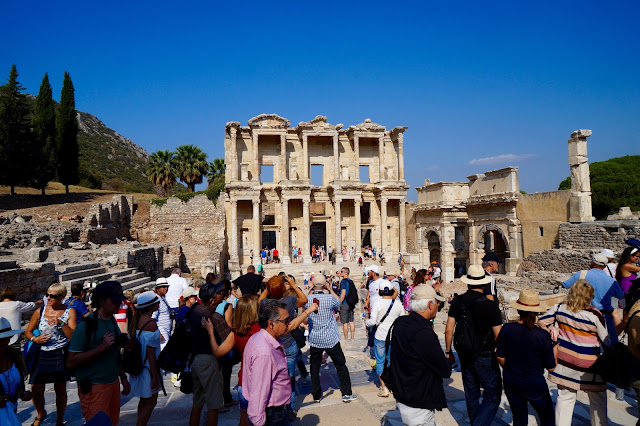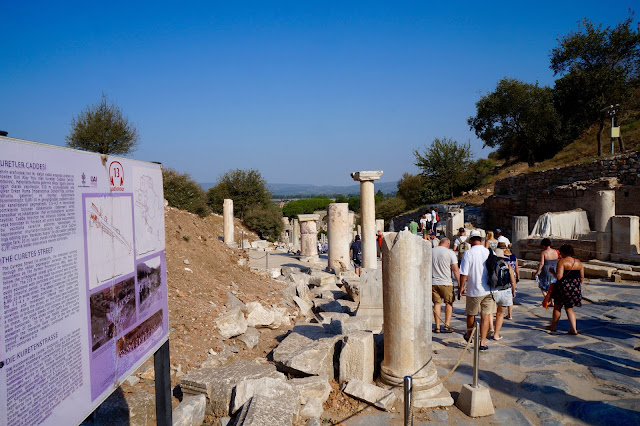Kusadasi, Turkey
Mary's House, Ephesus Ruins, and the Basilica of St John
In 356BC the Greeks built an Ionic temple dedicated to Artemis, the fertility goddess, which was one of the Seven Wonders of the ancient world. During the 2nd century BC, Ephesus was the fourth largest city in the eastern Roman Empire. Ephesus is and was famous for its temple for Artemis, the Library of Celsus and its medical school.
Ephesus was established as a port. Because of the silt that has deposited itself since Biblical times, the sea is further away now. It was an important commercial center because of its strategic location. It is also a very fertile valley.
This is also the area where it is thought that Mary, mother of Jesus, spent her last years on this earth. According to tradition, John brought her here to live out her later years.
 |
| This house is built on the foundation that was discovered and through tradition thought to be Mary's house. |
 |
| A country gave this statue of Mary to Turkey. |
Ephesus Ruins
Ephesus was the market of Asia Minor. In those days trade followed the river valleys. Ephesus stood at the mouth of the Cayster and therefore commanded the richest hinterland in Asia Minor. Revelation 18:12-13 gives a description of the trade of Ephesus. She was known as "The Treasure House of Asia" and someone has called her, "The Vanity Fair of Asia Minor." (taken from Bill Barclay)

 |
| Pipes were found within the ruins demonstrating the advanced water system they had. |
When Paul came to this cosmopolitan city around the year 53, it was already home to a small Christian community, established by St. John. It was in Ephesus that Paul wrote his First Letter to the Corinthians. While in Ephesus Paul tended to new converts and tried tirelessly to make more. Paul stayed here over three years. The church of Ephesus became the head of the Seven Churches in western Asia Minor. (Taken from ephesus.us)
This is Curetes Street (in antiquity, the Embolus) running through the valley depression between the two city mountains as the former Processional Way, does not follow the orthogonal street grid of the Hellenistic-Roman city. The 210m long main boulevard was prestigiously equipped with porticoes and marble paving in the early Imperial period. A sewer channel ran under the 6.8-10m wide street. The shops (tabernae) lay behind the 3.5-4.5m deep porticoes in which tradesmen, artisans, and innkeepers offered their goods and services. Along the street, an inscribed base supporting a marble or bronze statue stood in front of each column; on these, the good deeds of citizens and benefactors were honored. The steep street (with a difference in elevation of 20m) was finally closed to traffic through the “Heracles Gate” built in the late antique period. Maintenance repairs continued well into the 6th/7th centuries A.D. (Taken from sign)
 |
| It was ever so exciting to walk down the streets Paul once walked. To be at a place I have heard of all my life, priceless! |
 |
| Isn't he precious! I don't think he is quite as old as his perch! We are finding cats everywhere. I wonder how much influence Egypt had on this area regarding cats. |

 |
 |
| Another public restroom area. I find it interesting that these areas are so well preserved. Definitely no time to be modest. |
In the land that is now Turkey, a wide marble road slopes down to one of the largest libraries of the ancient world. Between 12,000 and 15,000 scrolls were housed in the grand Library of Celsus in the Roman city, Ephesus.
Designed by the Roman architect Vitruoya, the library was built in memory of Celsus Polemeanus, who was a Roman senator, General Governor of the Province of Asia, and a great lover of books.
Celsus' son, Julius Aquila, began the construction in 110 AD. The library was completed by Julius Aquila's successors in 135 AD.
Celsus was buried beneath the ground floor in a lead container inside a marble tomb. A corridor behind the north wall leads to the vault.
The Library of Celsus was remarkable not only for its size and its beauty, but also for its clever and efficient design. (taken from architecture.about.com)
 |
| This was not there when Paul walked the streets. It was built in 110AD by Gaius Julius Aquila. |
 |
| It is amazing to hear all the steps they took to make this place so acoustically wonderful. |
This is the most magnificent structure in Ephesus ancient city. The Great Theatre is located on the slope of Panayir Hill, opposite the Harbor Street, and easily seen when entering from the south entrance to Ephesus. It was first constructed in the Hellenistic Period, in the third century BC during the reign of Lysimachos, but then during the Roman Period, it was enlarged and formed its current style that is seen today.
It is the largest in Anatolia and has the capacity of 25,000 seats. The cavea has sixty six rows of seats, divided by two diazoma (walkway between seats) into three horizontal sections. There are three sections of seats. In the lower section, Marble pieces, used for restoration, and the Emperor's Box were found. The seats with backs ,made of marble, were reserved for important people. The audience entered from the upper cavea. The stage building is three-storied and 18 meters high. The facade facing the audience was ornamented with reliefs, columns with niches, windows and statues. There are five doors opening to the orchestra area, the middle one of which is wider than the rest. This enhanced the appearance of the stage, giving it a bigger, monumental look. The theatre was used not only for concerts and plays, but also for religious, political and philosophical discussions and for gladiator and animal fights. (Taken from ephesus.us) |
Basilica of St John
It is believed that the evangelist St. John had spent his last years in the region around Ephesus and buried in the southern slope of Ayosolug Hill. Three hundred years after the death of St. John, a small chapel was constructed over the grave in the 4th century. The church of St John was changed into a marvelous basilica during the region of Emperor Justinian (527 -565 AD). (Taken from ephesus.us)
|
 |
 |
| The baptismal. |
Views from St John's Basilica
We were given a show representing Mark Antony and Cleopatra entering Ephesus.
 |






















































No comments:
Post a Comment